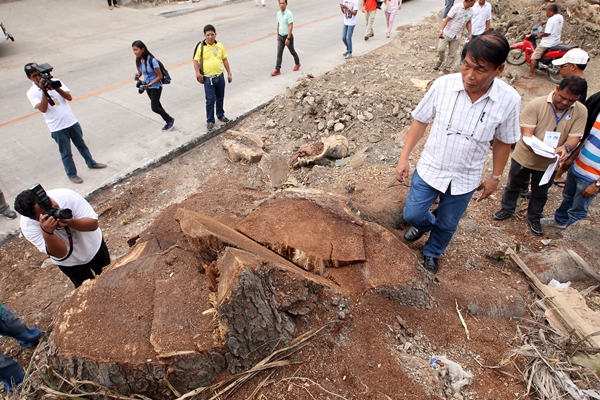
Dr. Roger Guzman (2nd from right) with DENR foresters led by Filemon Embalzado Jr. (right) inspects the stump of the fifth acacia tree that was cut by DPWH to pave way on the widening road project in Naga City.(CDN PHOTO/TONEE DESPOJO)
Not all sick trees die or end up being cut down.
A layer of tissue underneath the bark called the cambium still provides cells for growth, said forester Mark Bagsit of the Foundation for the Philippine Environment (FPE).
“While a tree’s cambium is still alive, it can still survive. Trees have a mechanism to heal its own wounds just like people. If we get wounded, eventually the wound will heal and close. It’s the same with trees,” he said.
Cebu Daily News showed Bagsit the Powerpoint slides of the Department of Environment and Natural Resources (DENR) 7 with their assessment and photos of roadside trees including century-old Acacias in Naga City and San Fernando town which were recommended for cutting.
According to the DENR, over 80 trees in the south Cebu highway are “diseased or defective.”
Bagsit said silvicultural interventions can still be done to rehabilitate a tree depending on the extent of damage.
1. Tree surgery can be done for decayed trees or those with cavities. If the cavity is in a branch, pruning can be done to balance the tree’s weight.
2. For leaning or inclined trees, pruning can also lessen the weight of the part that has a tendency to fall down.
3. For cankers, insect infestation and other symptoms of disease, “sanitation cutting” can help.
Bagsit, a licensed forester and Luzon Coordinator for Special Projects of FPE said this process is not outright cutting.
“Basically this is removal of a part or parts of a tree affected by any signs or symptoms of disease and pests to prevent it from spreading,” he said.
This response is different from “sanitation harvesting” where the whole tree is affected and should be removed. This is usually done in plantations.
He said proper sanitation cutting should have been used on the Acacia trees in Naga City instead of cutting them down outright.
The haste in a decision to cut down roadside trees may arise from a sense of resignation than actual science, the forester said.
“Maybe the DENR thought that the tree can’t survive even with tree surgery because they can’t do anything since there is a road widening project. Baka nasa isip lang, bakit ba kailangan i-tree surgery, eh, apektado naman ng road widening?”
He said the public should remember that trees are important not just in the area where they stand because trees – which absorb carbon monoxide in the air and produce oxygen – helps in lessening the impact of global warming.
Read all about the Naga trees issues here!